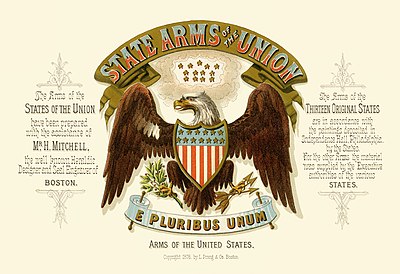
Historical coats of arms of the U.S. states date back to the admission of the first states to the Union. Despite the widely accepted practice of determining early statehood from the date of ratification of the United States Constitution, many of the original colonies referred to themselves as states shortly after the Declaration of Independence was signed on 4 July 1776. Committees of political leaders and intellectuals were established by state legislatures to research and propose a seal and coat of arms. Many of these members were signers of the Articles of Confederation, Declaration of Independence, and United States Constitution. Several of the earliest adopted state coats of arms and seals were similar or identical to their colonial counterparts.
State Arms of the Union, illustrated by Henry Mitchell and published by Louis Prang (known as the father of the lithographic industry), offers historically accurate renderings of the state's coats of arms as they existed in 1876. An accomplished engraver with the Bureau of Engraving and Printing for 40 years, Mitchell was responsible for engraving several coats of arms for official state use as well as arms for well-known educational and philanthropic organizations. The illustrations are presented alongside proof impressions from the engraved dies used to print the state arms on the first issue of United States National Bank Notes.